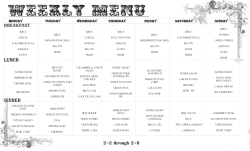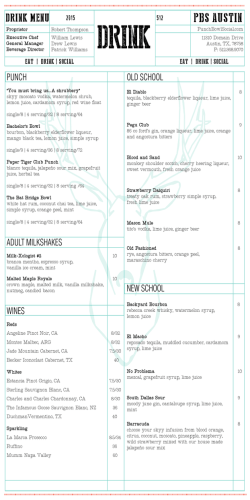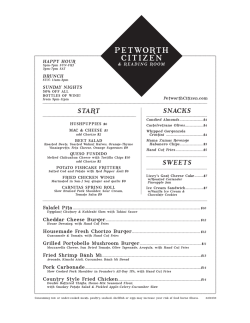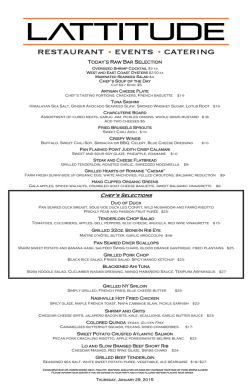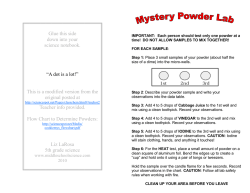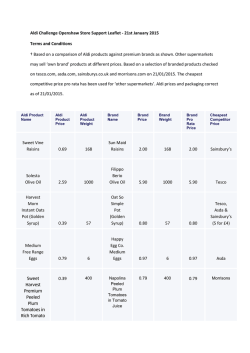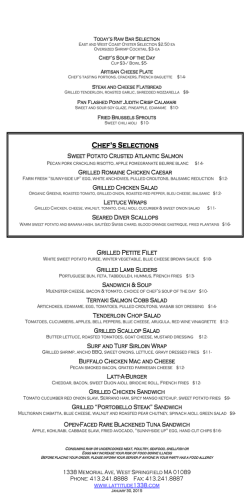
Lesson 11: Comparing Ratios Using Ratio Tables
Lesson 11 NYS COMMON CORE MATHEMATICS CURRICULUM 6•1 Lesson 11: Comparing Ratios Using Ratio Tables Student Outcomes Students solve problems by comparing different ratios using two or more ratio tables. Classwork Example 1 (10 minutes) Allow students time to complete the example. If time permits, allow student volunteers to come to the board and explain their solutions. Students will be asked to complete two questions. Example 1 Create four equivalent ratios (𝟐 by scaling up and 𝟐 by scaling down) using the ratio 𝟑𝟎 to 𝟖𝟎. There are various possible answers. Some examples of scaling down are 𝟑: 𝟖, 𝟔: 𝟏𝟔, 𝟗: 𝟐𝟒, 𝟏𝟐: 𝟑𝟐, 𝟏𝟓: 𝟒𝟎, 𝟏𝟖: 𝟒𝟖, 𝟐𝟏: 𝟓𝟔, 𝟐𝟒: 𝟔𝟒, and 𝟐𝟕: 𝟕𝟐. Some examples of scaling up are 𝟔𝟎: 𝟏𝟔𝟎, 𝟗𝟎: 𝟐𝟒𝟎, 𝟏𝟐𝟎: 𝟑𝟐𝟎, etc. Write a ratio to describe the relationship shown in the table. Hours 𝟐 𝟓 𝟔 𝟏𝟎 Number of Pizzas Sold 𝟏𝟔 𝟒𝟎 𝟒𝟖 𝟖𝟎 The ratio used to create the table is 𝟏: 𝟖, which means that there are 𝟖 pizzas being sold every hour. Exercise 1 (10 minutes) Students work in small groups or with partners for the exercise. Show the examples of three students and their texting speeds. Tables are provided in the student materials showing different amounts of words being texted by different students at different times. Display these tables to have a visual representation to use during discussion. Have students discuss possible ways of using the tables to figure out who can text the fastest. Exercise 1 The following tables show how many words each person can text in a given amount of time. Compare the rates of texting for each person using the ratio table. Michaela Minutes Words 𝟑 𝟏𝟓𝟎 Lesson 11: Date: 𝟓 𝟐𝟓𝟎 𝟕 𝟑𝟓𝟎 𝟗 𝟒𝟓𝟎 Comparing Ratios Using Ratio Tables 10/21/1412:20 PM5/19/14 © 2014 Common Core, Inc. Some rights reserved. commoncore.org 76 This work is licensed under a Creative Commons Attribution-NonCommercial-ShareAlike 3.0 Unported License. Lesson 11 NYS COMMON CORE MATHEMATICS CURRICULUM 6•1 Jenna Minutes Words 𝟐 𝟗𝟎 𝟒 𝟏𝟖𝟎 𝟔 𝟐𝟕𝟎 𝟖 𝟑𝟔𝟎 𝟑 𝟏𝟐𝟎 𝟔 𝟐𝟒𝟎 𝟗 𝟑𝟔𝟎 𝟏𝟐 𝟒𝟖𝟎 Maria Minutes Words Michaela texts the fastest because she texts 𝟓𝟎 words per minute, next is Jenna who texts 𝟒𝟓 words per minute, and last is Maria who texts 𝟒𝟎 words per minute. While students are discussing the tables, ask the following: How can we compare the texting rates? Even though there is not a time that is common to all three tables, is it still possible to use the tables to determine which girl has the fastest texting rate and which has the slowest? We can find the values of the ratios, and then put them in order to see who is fastest and slowest. Why can’t I just pick the student that has the largest number of words at the end of the table? (This question is meant to help students with a common misconception.) The ratios show how many words each person can text in one minute. How can we use the ratios to help us compare the texting rates of the three girls? Answers will vary. Sample Response: I could compare the first and third tables by comparing the words at 3 and 9 minutes. I could compare the second and third tables by comparing the words at 6 minutes. If you used ratios to compare, what do the ratios mean in the context of this problem? Answers will vary. Students should see that comparing the girls’ texting rates using the table can be a struggle because there is not a common time for all three tables. The times (minutes) are not equal in all tables. The ratio of words to minutes needs to be used to compare the texting rates. If there were a fourth person, Max, who can text 55 words per minute, how could we create a table to show his texting speed? (This question is to help prepare the class for the next exercise and to review concepts learned in previous lessons.) The entries in the Minutes row would go up by 1 as the entries in the Words row goes up by 55. Complete the table so that it shows Max has a texting rate of 𝟓𝟓 words per minute. Max Minutes 𝟏 𝟐 𝟑 𝟒 Words 𝟓𝟓 𝟏𝟏𝟎 𝟏𝟔𝟓 𝟐𝟐𝟎 Lesson 11: Date: Comparing Ratios Using Ratio Tables 10/21/1412:20 PM5/19/14 © 2014 Common Core, Inc. Some rights reserved. commoncore.org 77 This work is licensed under a Creative Commons Attribution-NonCommercial-ShareAlike 3.0 Unported License. Lesson 11 NYS COMMON CORE MATHEMATICS CURRICULUM 6•1 Exercise 2 (10 minutes): Making Juice (Comparing Juice to Water) Students work with a partner or in a small group. Students follow the set of instructions that leads them through examples and asks them questions to help them dig deeper. The questions ask students to compare the ratio of water to juice for a variety of beverages. Students can also find the value of the ratio in order to determine which juice has a higher water-to-juice ratio. Exercise 2: Making Juice (Comparing Juice to Water) a. The tables below show the comparison of the amount of water to the amount of juice concentrate (JC) in grape juice made by three different people. Whose juice has the greatest water-to-juice concentrate ratio, and whose juice would taste strongest? Be sure to justify your answer. Franca’s juice has the greatest amount of water in comparison to juice concentrate, followed by Milton, and then Laredo. Because Laredo’s juice has the least amount of water in comparison to juice concentrate, his juice would taste the strongest. Put the juices in order from the juice containing the most water to the juice containing the least water. Franca, Milton, Laredo Discussing what these ratios mean and what the values of the ratios look like will help give meaning to the problem for students who are struggling. Students should see that the value of the water-to-juice concentrate ratio for Franca’s juice is greater than the value of the water-to-juice concentrate ratio for Laredo’s and Milton’s juices. Explain how you used the values in the table to determine the order. Laredo makes his juice by combining three cups of water for every one cup of juice concentrate. Franca makes her juice by combining five cups of water for every one cup of juice concentrate. Milton makes his juice by combining four cups of water for every one cup of juice concentrate. What ratio was used to create each table? Laredo 𝟑: 𝟏, Franca 𝟓: 𝟏, Milton 𝟒: 𝟏 Explain how the ratio could help you compare the juices. Answers will vary. As you visit the groups or partners as they are working, discuss the third column in the table. Some students may have compared using the total as well. The next question does not have equal values in the columns for all three tables, so other reasoning will need to be used to solve the problems. Lesson 11: Date: Comparing Ratios Using Ratio Tables 10/21/1412:20 PM5/19/14 © 2014 Common Core, Inc. Some rights reserved. commoncore.org 78 This work is licensed under a Creative Commons Attribution-NonCommercial-ShareAlike 3.0 Unported License. Lesson 11 NYS COMMON CORE MATHEMATICS CURRICULUM Laredo’s Juice Water JC Total 12 2 14 18 3 21 30 5 35 42 7 49 Franca’s Juice Water JC 15 6 20 8 35 14 50 20 Total 21 28 49 70 6•1 Milton’s Juice Water JC Total 16 6 22 24 9 33 40 15 55 64 24 88 Students may use the ratios to compare the data. Struggling students, and even average students, may be challenged when comparing these ratios. By finding the value of the ratios, it will be easier for students to compare the data. It should be fairly obvious that Laredo has the juice with the most water compared to juice concentrate. If students use the tables to compare Franca’s ratio of the amount of water to the amount of juice concentrate with Milton’s ratio of the amount of water to the amount of juice concentrate, they can look for numbers the columns have in common. b. The next day, each of the three people made juice again, but this time they were making apple juice. Whose juice has the greatest water-to-juice concentrate ratio, and whose juice would taste the strongest? Be sure to justify your answer. Put the juices in order from the strongest apple taste to the weakest apple taste. Franca, Milton, Laredo Explain how you used the values in the table to determine the order. Answers will vary. Based on the data in the tables, Milton added more water to his juice than Franca added to her juice. So, the order of the juice with the strongest apple taste to the weakest apple taste is Franca, Milton, Laredo. Students may use the ratios to get equal amounts of water and then compare the amounts of juice concentrate, or students may use the ratios to get equal amounts of juice concentrate and then compare the amounts of water. 𝟓: 𝟐 -------- 𝟓 × 𝟖: 𝟐 × 𝟖 ------- 𝟒𝟎: 𝟏𝟔 MP.7 𝟖: 𝟑 -------- 𝟖 × 𝟓: 𝟑 × 𝟓 ------- 𝟒𝟎: 𝟏𝟓 Now we can compare and see that Franca’s juice has more juice concentrate compared to water than Milton’s juice. Students also have the option of comparing the values of the ratios to see which value is greater. Then they can compare 15 6 to 16 6 and see that the value of Milton’s ratio is larger than the value of Franca’s ratio. Lesson 11: Date: Comparing Ratios Using Ratio Tables 10/21/1412:20 PM5/19/14 © 2014 Common Core, Inc. Some rights reserved. commoncore.org 79 This work is licensed under a Creative Commons Attribution-NonCommercial-ShareAlike 3.0 Unported License. Lesson 11 NYS COMMON CORE MATHEMATICS CURRICULUM 6•1 What ratio was used to create each table? Laredo: 𝟔: 𝟏 Franca: 𝟓: 𝟐 Milton: 𝟖: 𝟑 Explain how the ratio could help you compare the juices. Answers will vary. How was this problem different than the grape juice questions in part (a)? Answers will vary. c. Max and Sheila are making orange juice. Max has mixed 𝟏𝟓 cups of water with 𝟒 cups of juice concentrate. Sheila has made her juice by mixing 𝟖 cups water with 𝟑 cups of juice concentrate. Compare the ratios of juice concentrate to water using ratio tables. State which beverage has a higher juice concentrate-to-water ratio. Max Sheila 𝟒 𝟏𝟓 JC Water 𝟖 𝟑𝟎 𝟏𝟐 𝟒𝟓 𝟑 𝟖 JC Water 𝟔 𝟏𝟔 𝟗 𝟐𝟒 𝟏𝟐 𝟑𝟐 Sheila has a higher juice concentrate-to-water ratio because she mixed 𝟏𝟐 cups of juice concentrate to only 𝟑𝟐 cups of water. Max’s juice would be more watery because he would have 𝟒𝟓 cups of water with the 𝟏𝟐 cups of juice concentrate. MP.7 d. Victor is making recipes for smoothies. His first recipe calls for 𝟐 cups of strawberries and 𝟕 cups of other ingredients. His second recipe says that 𝟑 cups of strawberries are combined with 𝟗 cups of other ingredients. Which smoothie recipe has more strawberries compared to other ingredients? Use ratio tables to justify your answer. Recipe #2 has more strawberries compared to other ingredients. Recipe #1 Strawberries Other Recipe #2 𝟐 𝟕 𝟒 𝟏𝟒 𝟔 𝟐𝟏 Strawberries Other 𝟑 𝟗 𝟔 𝟏𝟖 𝟗 𝟐𝟕 Recipe #𝟐 has more strawberries compared to the other ingredients. When comparing 𝟔 cups of strawberries, there were less other ingredients added in recipe #2 than in recipe #1. Students that are struggling can use the value of the ratio to compare the data. However, in parts (c) and (d), struggling students may need to see the comparison of part to whole or get equal amounts of water in part (c) and “other” in part (d) to make sense of the problem. If students use this comparison, they may want to use multiplication instead of adding to make the table. For example, in part (d), students may want to see how many strawberries would be needed when 63 cups of other ingredients are added. 2: 7 becomes 18 to 63. 3: 9 becomes 21 to 63. This might be an easier way for students to see that there are more strawberries in recipe #2. Lesson 11: Date: Comparing Ratios Using Ratio Tables 10/21/1412:20 PM5/19/14 © 2014 Common Core, Inc. Some rights reserved. commoncore.org 80 This work is licensed under a Creative Commons Attribution-NonCommercial-ShareAlike 3.0 Unported License. Lesson 11 NYS COMMON CORE MATHEMATICS CURRICULUM 6•1 While students are working, circulate and ask students to share their solving strategies. It is important to also ask the students to prove their claims. If a student has simply written that one beverage has a higher amount of water per juice than the other, ask the student to prove or explain how the answer was determined. Students share how they have compared the values in the table. Closing (10 minutes) Today we used ratio tables to compare two ratios that were not equivalent and answered questions about which situation would reach a given level first. Can anyone think of another way to compare two different ratios? The value of a ratio might be useful because then we could determine which ratio had the larger or smaller value. Lesson Summary Ratio tables can be used to compare two ratios. Look for equal amounts in a row or column to compare the second amount associated with it. 𝟑 𝟕 𝟔 𝟏𝟒 𝟏𝟐 𝟐𝟖 𝟑𝟎 𝟕𝟎 𝟏𝟎 𝟏𝟔 𝟐𝟓 𝟒𝟎 𝟑𝟎 𝟒𝟖 𝟒𝟓 𝟕𝟐 You can also extend the values of the tables in order to get comparable amounts. Another method would be to compare the values of the ratios. Write the values of the ratios as fractions and then use your knowledge of fractions to compare the ratios. When ratios are given in words, students can create a table of equivalent ratios in order to compare the ratios. 𝟏𝟐: 𝟑𝟓 compared to 𝟖: 𝟐𝟎 Quantity 1 Quantity 2 𝟏𝟐 𝟑𝟓 𝟐𝟒 𝟕𝟎 𝟑𝟔 𝟏𝟎𝟓 𝟒𝟖 𝟏𝟒𝟎 Quantity 1 Quantity 2 𝟖 𝟐𝟎 𝟓𝟔 𝟏𝟒𝟎 Exit Ticket (5 minutes) Lesson 11: Date: Comparing Ratios Using Ratio Tables 10/21/1412:20 PM5/19/14 © 2014 Common Core, Inc. Some rights reserved. commoncore.org 81 This work is licensed under a Creative Commons Attribution-NonCommercial-ShareAlike 3.0 Unported License. Lesson 11 NYS COMMON CORE MATHEMATICS CURRICULUM Name ___________________________________________________ 6•1 Date____________________ Lesson 11: Comparing Ratios Using Ratio Tables Exit Ticket Beekeepers sometimes supplement the diet of honey bees with sugar water to help promote colony growth in the spring and help the bees survive through fall and winter months. The tables below show the amount of water and the amount of sugar used in the Spring and in the Fall. Spring Sugar Water Mixture Sugar (cups) Water (cups) Fall Sugar Water Mixture Sugar (cups) Water (cups) 6 4 4 2 15 10 10 5 18 12 14 7 27 18 30 15 Write a sentence that compares the ratios of the number of cups of sugar to the number of cups of water in each table. Explain how you determined your answer. Lesson 11: Date: Comparing Ratios Using Ratio Tables 10/21/1412:20 PM5/19/14 © 2014 Common Core, Inc. Some rights reserved. commoncore.org 82 This work is licensed under a Creative Commons Attribution-NonCommercial-ShareAlike 3.0 Unported License. Lesson 11 NYS COMMON CORE MATHEMATICS CURRICULUM 6•1 Exit Ticket Sample Solutions Beekeepers sometimes supplement the diet of honey bees with sugar water to help promote colony growth in the spring and help the bees survive through fall and winter months. The tables below show the amount of water and the amount of sugar used in the Spring and in the Fall. Fall Sugar Water Mixture Sugar (cups) Water (cups) 𝟒 𝟐 𝟏𝟎 𝟓 𝟏𝟒 𝟕 𝟑𝟎 𝟏𝟓 Spring Sugar Water Mixture Sugar (cups) Water (cups) 𝟔 𝟒 𝟏𝟓 𝟏𝟎 𝟏𝟖 𝟏𝟐 𝟐𝟕 𝟏𝟖 Write a sentence that compares the ratios of the number of cups of sugar to the number of cups of water in each table. The value of the ratio for the Spring Sugar Water is 𝟏.𝟓 𝟏 𝟐 , while the value of the ratio of the Fall Sugar Water is . 𝟏 Therefore, the Fall Sugar Water Mixture has more sugar mixed in for every cup of water added to the mixture than the Spring Sugar Water Mixture. Explain how you determined your answer. 𝟔 Spring: Fall: 𝟒 𝟐 𝟒 = = 𝟑 𝟐 = 𝟏.𝟓 𝟏 𝟐 𝟏 Problem Set Sample Solutions 1. Sarah and Eva were swimming. a. Use the ratio tables below to determine who the faster swimmer is. Sarah Time (min) Distance (meters) 𝟑 𝟕𝟓 𝟓 𝟏𝟐𝟓 𝟏𝟐 𝟑𝟎𝟎 𝟏𝟕 𝟒𝟐𝟓 𝟐 𝟓𝟐 𝟕 𝟏𝟖𝟐 𝟏𝟎 𝟐𝟔𝟎 𝟐𝟎 𝟓𝟐𝟎 Eva Time (min) Distance (meters) Eva is the faster swimmer because she swims 𝟐𝟔 meters in 𝟏 minute, which is faster than Sarah who swims 𝟐𝟓 meters in 𝟏 minute. b. Explain the method that you used to determine your answer. Answers will vary. 2. A 𝟏𝟐𝟎 lb. person would weigh about 𝟐𝟎 lb. on the earth’s moon. A 𝟏𝟓𝟎 lb. person would weigh about 𝟐𝟖 lb. on Io, a moon of Jupiter. Use ratio tables to determine which moon would make a person weigh the most. Answers will vary. A person on Io will weigh more than a person on our moon. Lesson 11: Date: Comparing Ratios Using Ratio Tables 10/21/1412:20 PM5/19/14 © 2014 Common Core, Inc. Some rights reserved. commoncore.org 83 This work is licensed under a Creative Commons Attribution-NonCommercial-ShareAlike 3.0 Unported License.
© Copyright 2025
